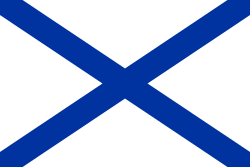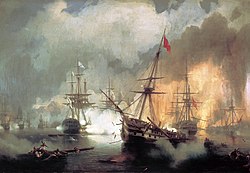Imperial Russian Navy
The Imperial Russian Navy (in Russian: Российский императорский флот) was the navy of the Russian Empire (and its predecessor: Tsardom of Russia), from 1696 until the start of the Russian Revolution in 1917.
| Imperial Russian Navy | |
|---|---|
| Российский императорский флот | |
 Emblem of the Imperial Russian Navy | |
| Founded | 1696 |
| Disbanded | 1917 |
| Country | |
| Allegiance | |
| Type | Navy |
| Patron | Saint Nicholas the Wonderworker |
| Engagements | Russo-Turkish War of 1686–1700 Great Northern War |
| Commanders | |
| Commander-in-chief | Russian Emperor |
| Minister of the Navy | See list |
| Notable commanders | Peter the Great Fyodor Apraksin |
| Insignia | |
| Ensign |  |
| Jack |  |
| Pennant |  |
History

It was founded by Tsar Peter the Great. This was due to the fact that Russia did not have naval forces[1] and the inexperience of its inhabitants in naval architecture, after a visit to Amsterdam, Tsar Peter would learn naval construction in detail, the first ship would be the Frigate Oryol (Eagle in English), after the victory against the Ottomans in Azov, the Black Sea Fleet would be created, over time the Fleet would grow. In 1740 the Baltic Fleet based in St. Petersburg would be founded after several victories against the Swedish Fleet. This was during the Russo-Turkish Wars the Black Sea Fleet would be the main fleet against the Ottoman Influence in this Sea. Near the end of the 1700s, the Caspian, White Sea and Okhotsk Flotillas would be created.[2]
Battles
The Russians would also make Circumnavigation trips,[3] from the Pacific Coast of Russia to the north of the Hawaiian Islands, They would participate in the Napoleonic Wars against the Ottoman Navy, During the Crimean War, they would suffer a serious defeat against the Ottoman Empire, Great Britain, France and Sardinia,[4] then over time the fleet would increase in naval size becoming one of the largest existing fleets, During the War Against Japan, they would suffer a serious defeat which would make Russia look like a less strong country From what it appeared to be, the fleet would finally be dissolved after the Russian Revolution where it would be succeeded by the Soviet Navy in 1920.
Goto Predestinatsia, flagship of the Azov flotilla until 1711
Russian fleet under the command of Admiral Fyodor Ushakov, sailing through the Bosphorus.By M. M. Ivanov
The naval cathedral in Kronstadt was one of several cathedrals of the Imperial Russian Navy.
Battle of Navarino, by Ivan Aivazovsky, showing the Russian squadron, in line ahead (left-centre, white flags with blue transversal crosses) bombarding the Ottoman fleet (right, with red flags)
Clash between the Russian steam frigate Vladimir (ship, 1848) and the Turkish steam frigate Pervaz-ı Bahrî on 5 November 1853 – the first naval battle between steam ships in history
References
- ↑ Cracraft 2009.
- ↑ "History: Ministry of Defence of the Russian Federation". eng.mil.ru. Retrieved 2020-05-20.
- ↑ Norman E. Saul, Richard D. McKinzie. Russian-American Dialogue on Cultural Relations, 1776-1914 p 95. ISBN 0-8262-1097-X, 9780826210975
- ↑ Grant p. 12, 13, 15, etc. continuous throughout the book
Other websites
- Russian Submarine forces history
- History of the Russian Navy Archived 2016-06-10 at the Wayback Machine
- Web site focusing on submarine history and the works of Irish-American inventor, John Philip Holland and his company which was known as The Holland Torpedo Boat Company. See Fulton and look under Russian submarines (Som Class) Type 7-P.
- Russian submarine history can be located on this site.








